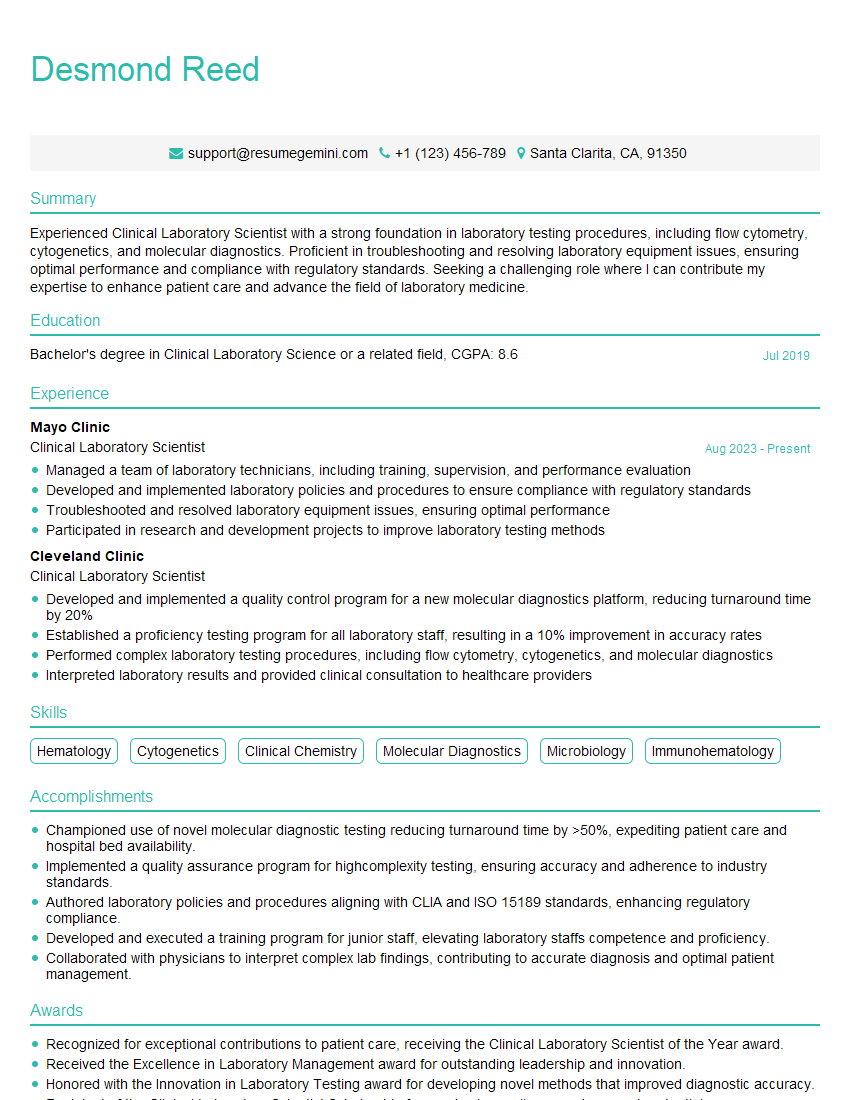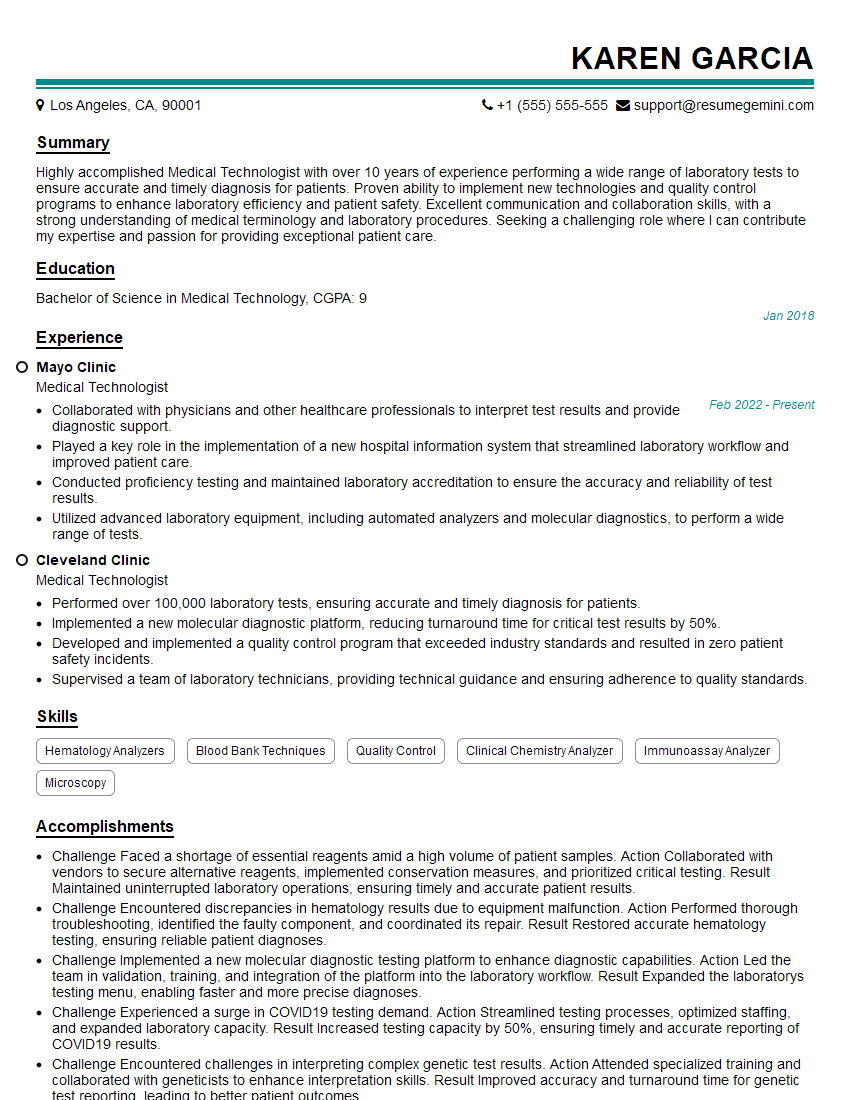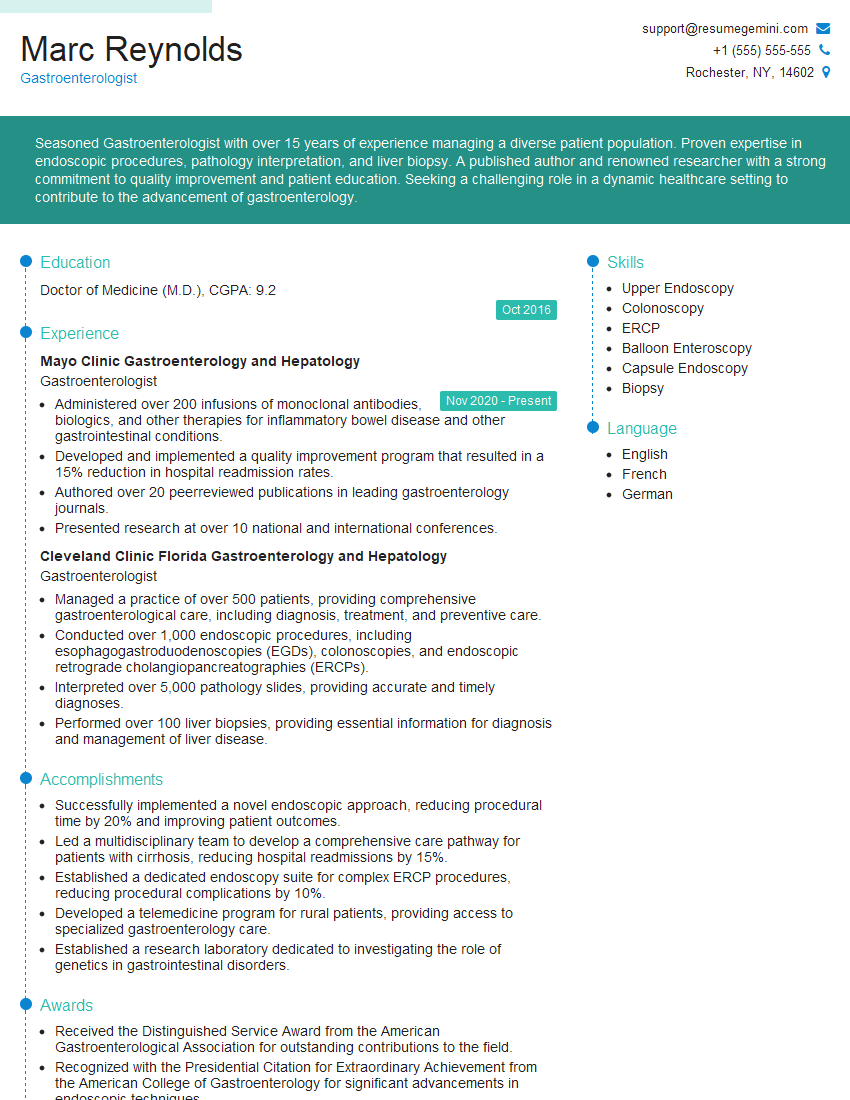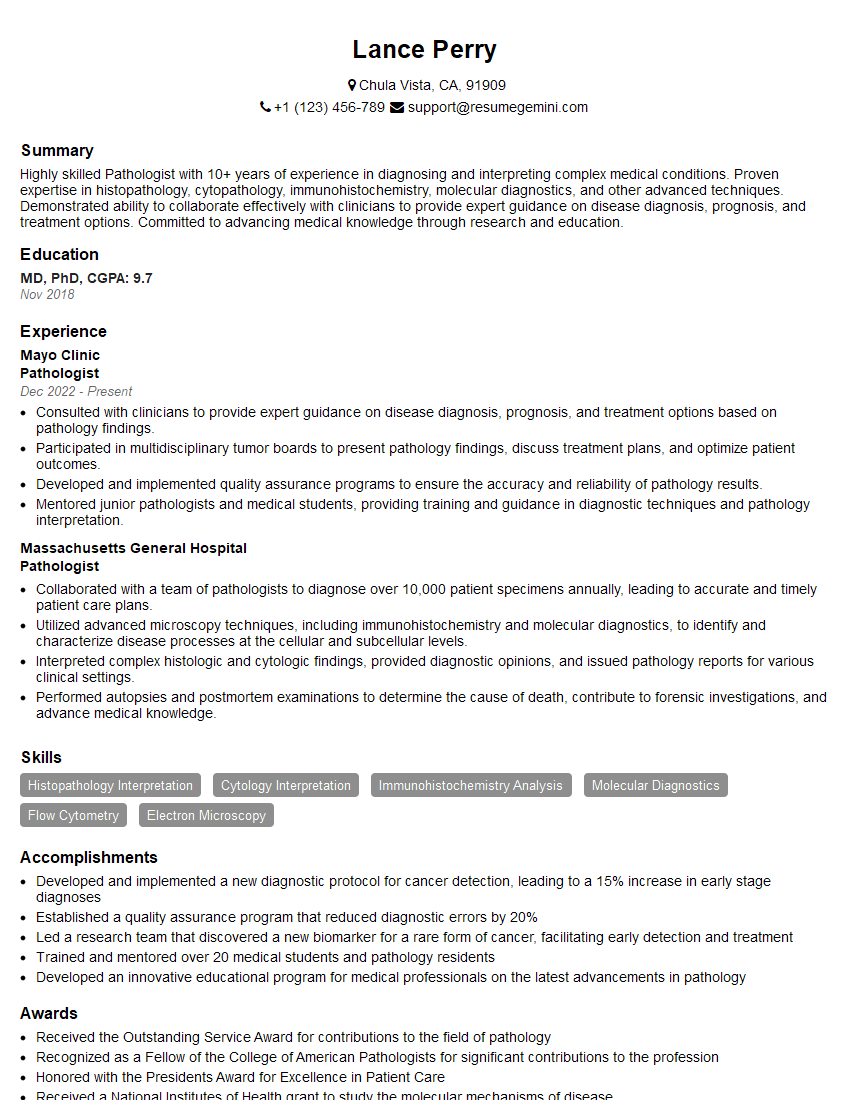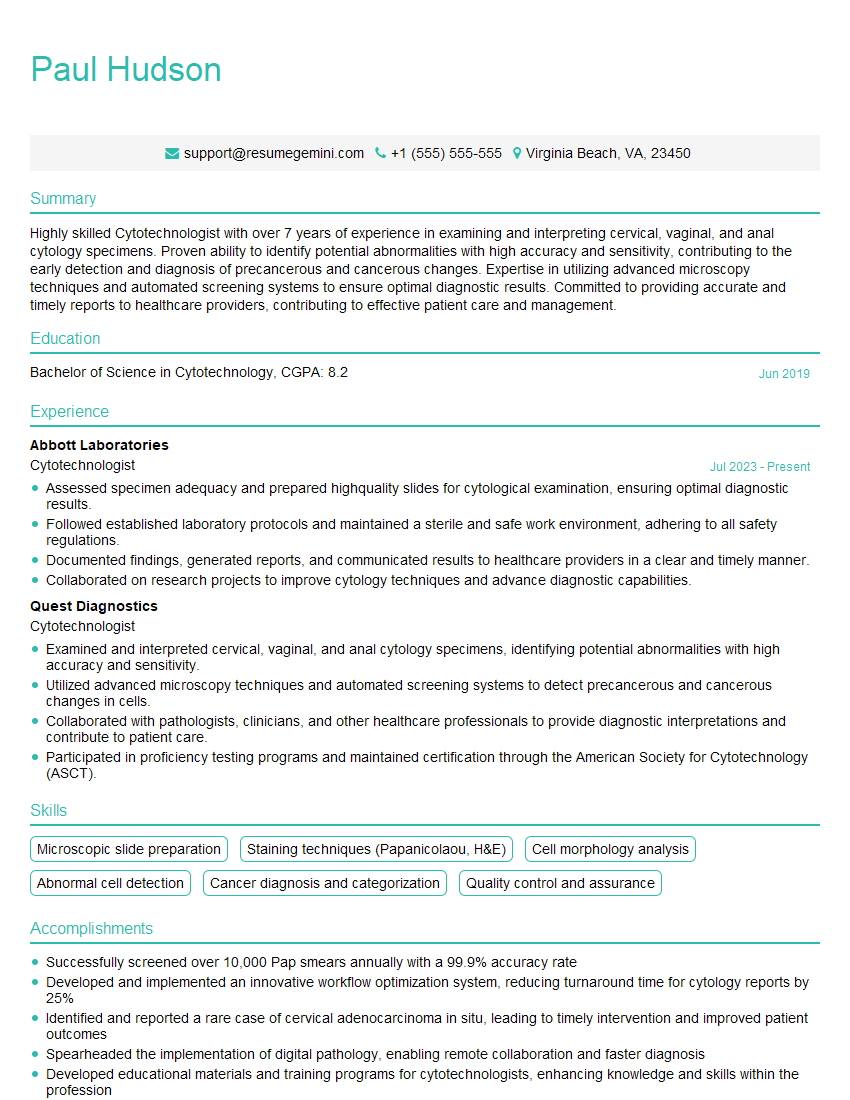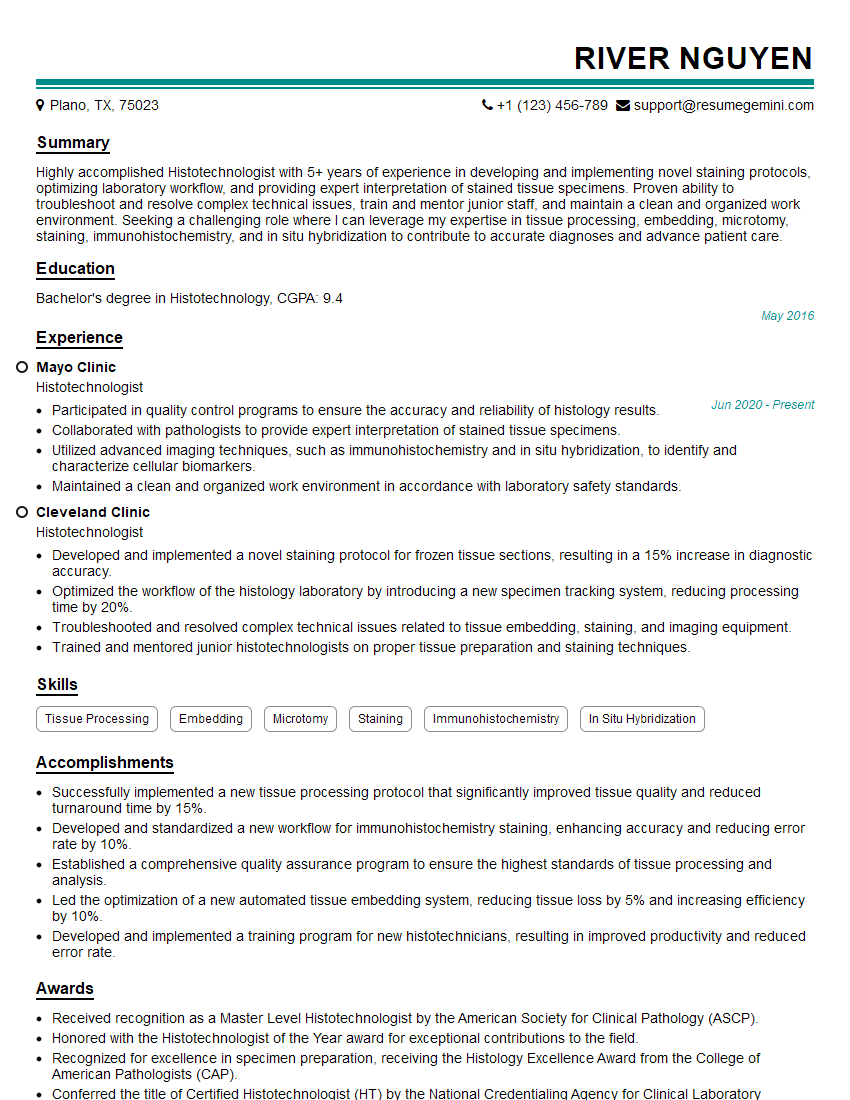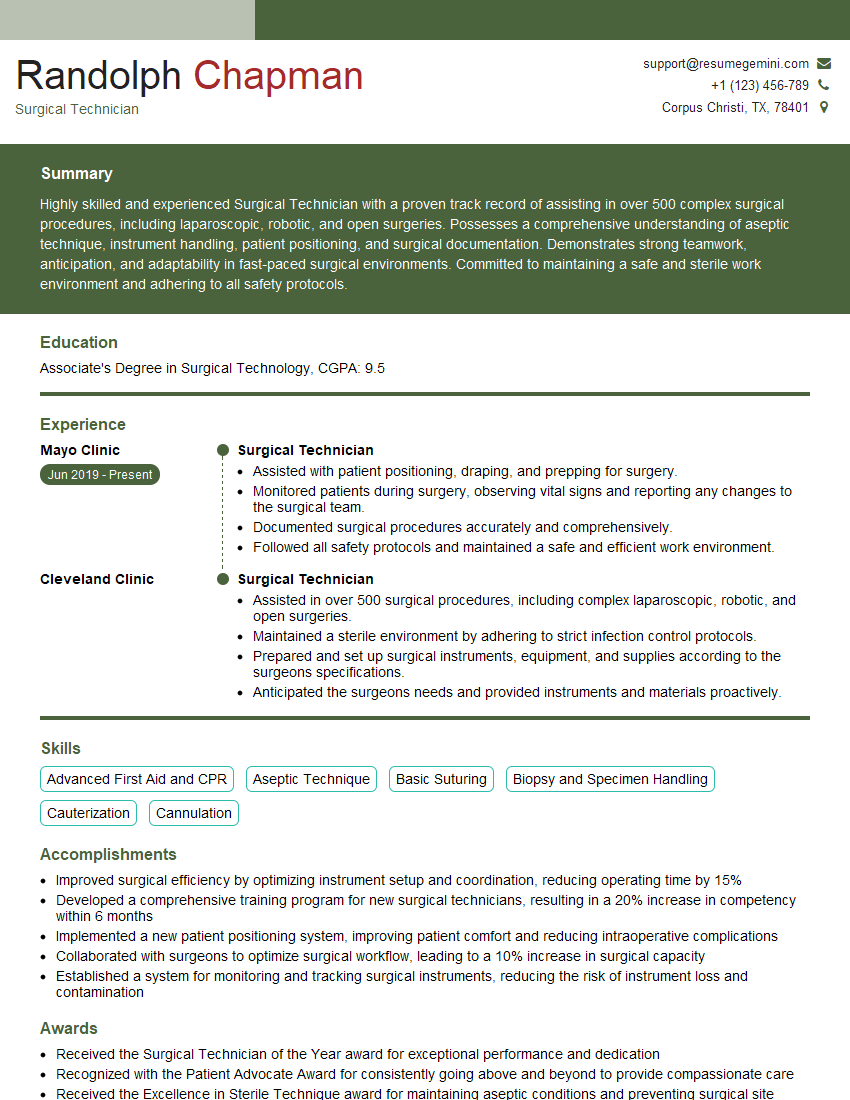Unlock your full potential by mastering the most common Liver Biopsy interview questions. This blog offers a deep dive into the critical topics, ensuring you’re not only prepared to answer but to excel. With these insights, you’ll approach your interview with clarity and confidence.
Questions Asked in Liver Biopsy Interview
Q 1. Describe the different types of liver biopsies and their indications.
Liver biopsies are crucial diagnostic tools providing tissue samples for microscopic examination. Several types exist, each chosen based on the clinical scenario and patient factors.
- Percutaneous Liver Biopsy: This is the most common type, involving needle insertion through the skin and into the liver under imaging guidance (usually ultrasound or CT). It’s indicated for evaluating a wide range of liver diseases, including cirrhosis, hepatitis, fatty liver disease, and liver masses.
- Transjugular Liver Biopsy: A needle is inserted into a vein in the neck (jugular vein) and advanced to the liver via the hepatic vein. This method is preferred for patients with significant coagulopathy (bleeding disorders) or ascites (fluid accumulation in the abdomen) as it reduces the risk of bleeding. It’s often used when a percutaneous approach is deemed too risky.
- Laparoscopic Liver Biopsy: A minimally invasive surgical procedure where a small incision is made, and a specialized instrument is used to obtain a liver tissue sample. This approach offers better visualization than percutaneous biopsy but is more invasive. It’s typically used when a larger sample is needed or when a specific area of the liver needs to be targeted.
Choosing the right type depends on a careful assessment of the patient’s condition, the suspected diagnosis, and the availability of resources. For example, a patient with severe ascites might be a better candidate for a transjugular biopsy to minimize bleeding risk, while a patient needing a larger sample for research might opt for a laparoscopic biopsy.
Q 2. Explain the procedure for performing a percutaneous liver biopsy.
A percutaneous liver biopsy is a relatively quick procedure, usually performed under ultrasound or CT guidance. The steps generally include:
- Preparation: The patient’s skin is cleaned and disinfected at the biopsy site. Local anesthetic is administered to numb the area.
- Needle Insertion: A thin needle is carefully advanced into the liver under real-time imaging guidance. The physician monitors the needle’s path to avoid vital structures like blood vessels and bile ducts.
- Tissue Acquisition: Once the needle is in the appropriate location within the liver, a small sample of liver tissue is obtained using either a cutting needle or a gun biopsy technique. The gun biopsy is more efficient at acquiring larger cores of tissue.
- Needle Removal: The needle is withdrawn, and pressure is applied to the biopsy site to prevent bleeding. A small bandage is placed over the insertion site.
- Post-Procedure Monitoring: The patient’s vital signs are monitored for several hours to detect any complications like bleeding or pain.
Imagine it like taking a tiny core sample from a cake – carefully selecting the right slice and extracting it without damaging the rest.
Q 3. What are the contraindications for a liver biopsy?
Several contraindications (reasons not to perform the procedure) exist for liver biopsy. These include:
- Uncontrolled Bleeding Disorder: Patients with significantly impaired blood clotting have a high risk of bleeding complications.
- Severe Liver Failure: Patients with severe liver dysfunction might not tolerate the procedure well.
- Ascites (in some cases): While transjugular biopsy can manage ascites, large amounts can increase the risk of complications in percutaneous biopsies.
- Localized Liver Tumors: Biopsy of very large or vascular tumors carries a high risk of bleeding.
- Uncontrolled Infection: Active infections can increase the risk of sepsis.
- Uncooperative Patient: The patient must remain still during the procedure; uncooperative patients make it unsafe.
Contraindications are decided on a case-by-case basis, considering the patient’s overall health and the potential risks versus benefits of the procedure. A thorough assessment is crucial to minimize potential dangers.
Q 4. What are the potential complications of a liver biopsy?
Despite being relatively safe, liver biopsies carry potential complications:
- Bleeding: This is the most common complication, ranging from minor bleeding at the puncture site to major intra-abdominal bleeding requiring transfusion or surgery. The risk is increased in patients with impaired coagulation.
- Pain: Mild to moderate pain is expected, but severe pain can indicate complications. Analgesics are usually prescribed post-procedure.
- Infection: Infection at the biopsy site is possible, requiring antibiotic treatment.
- Bile Leak: In rare cases, the needle can puncture the bile ducts, leading to a bile leak. This typically requires careful monitoring or intervention.
- Pneumothorax (collapsed lung): This is possible in percutaneous biopsies if the needle punctures the lung. It is less common with ultrasound guidance.
- Peritonitis (inflammation of the abdominal lining): This is a rare but serious complication indicating infection within the abdominal cavity.
The frequency of these complications varies depending on the technique, the experience of the operator, and the patient’s overall health. Open communication between physician and patient about the risks is crucial.
Q 5. How do you manage bleeding complications during or after a liver biopsy?
Management of bleeding complications depends on the severity.
- Minor Bleeding: Usually managed with direct pressure at the puncture site and close monitoring. Patients may need to be observed for several hours.
- Moderate Bleeding: Might necessitate intravenous fluids or blood transfusions. Serial hemoglobin measurements are necessary to monitor the blood loss.
- Major Bleeding: Requires immediate medical intervention, potentially including angioembolization (blocking the bleeding vessel through interventional radiology) or surgery. This might involve transferring the patient to a higher-level care facility.
Early identification of bleeding, diligent monitoring, and prompt intervention are key to minimizing morbidity and mortality. A post-procedure check with the patient is crucial in the first 24 hours to identify any unexpected symptoms.
Q 6. Describe the pre-biopsy patient preparation and assessment.
Pre-biopsy preparation is essential to ensure patient safety and accurate results. It involves several steps:
- Complete Medical History and Physical Examination: This includes a thorough review of the patient’s medical history, medications, allergies, and current health status. Specific attention is paid to coagulation parameters and liver function tests.
- Laboratory Tests: Blood tests, including complete blood count (CBC), prothrombin time (PT), partial thromboplastin time (PTT), and international normalized ratio (INR), are performed to assess the patient’s coagulation status and liver function. Additional tests depend on the clinical suspicion.
- Imaging Studies: Ultrasound or CT scan is typically performed to guide the biopsy needle and assess the liver anatomy. This helps the physician to choose the optimal biopsy location, avoiding major vessels.
- Informed Consent: Patients must be fully informed about the procedure, its benefits, risks, and potential complications before providing written consent.
- Patient Education: Patients should receive clear instructions about bowel preparation (if needed), fasting guidelines, and post-biopsy care. They are also counseled about the risks and what to expect.
The goal of pre-biopsy assessment is to identify and manage potential risks to ensure a safe and effective procedure. Patient education is paramount to alleviate anxiety and facilitate cooperation.
Q 7. How do you interpret a liver biopsy report?
Interpreting a liver biopsy report requires expertise in histopathology and hepatology. The report typically includes:
- Macroscopic Description: This describes the size, shape, color, and texture of the liver tissue sample.
- Microscopic Description: This is the core of the report, detailing the cellular structures and architectural changes observed under the microscope. It identifies the presence of inflammation, fibrosis (scarring), steatosis (fatty change), necrosis (cell death), and other abnormalities.
- Diagnosis: Based on the microscopic findings, a specific diagnosis is made, or differential diagnoses are suggested.
- Staging: In some cases, such as cirrhosis, the extent of liver damage is staged according to established systems.
- Additional findings: Any additional findings, such as the presence of microorganisms or other unusual features, are included.
Interpreting these findings necessitates knowledge of liver pathology, the correlation between histological features and clinical presentation, and an understanding of the patient’s medical history. For example, seeing significant inflammation and ballooning degeneration might suggest alcoholic hepatitis, while the presence of Mallory-Denk bodies would strongly support this diagnosis. Always consider the patient’s clinical picture alongside the histological results for a complete and accurate interpretation.
Q 8. Explain the significance of different histological findings in a liver biopsy.
Histological findings in a liver biopsy are crucial for diagnosing and staging liver diseases. The pathologist examines the tissue sample under a microscope, looking for various abnormalities. These findings can range from subtle changes to overtly destructive lesions. The significance lies in correlating these microscopic observations with the patient’s clinical picture and other investigations.
Inflammation: The presence of inflammatory cells (neutrophils, lymphocytes, etc.) indicates active liver injury. The pattern of inflammation (e.g., portal versus lobular) helps pinpoint the cause. For example, significant portal inflammation might suggest autoimmune hepatitis, whereas lobular inflammation is more often seen in viral hepatitis.
Fibrosis: This refers to the excessive deposition of collagen, representing scar tissue. The extent of fibrosis, graded using systems like METAVIR or Ishak scoring systems, reflects the severity of liver damage and the progression toward cirrhosis. A high degree of fibrosis is a serious finding.
Necrosis: This is the death of liver cells (hepatocytes). The pattern and extent of necrosis help identify the type of liver injury. For instance, piecemeal necrosis is characteristic of autoimmune hepatitis. Extensive necrosis can indicate fulminant hepatic failure.
Steatosis (Fatty Change): Accumulation of fat within hepatocytes is often seen in non-alcoholic fatty liver disease (NAFLD) and alcoholic liver disease (ALD). The extent of steatosis is graded, providing insight into disease severity.
Bile Duct Changes: Changes in bile ducts, such as inflammation (cholangitis) or destruction (destruction in primary biliary cholangitis), help diagnose biliary diseases.
Iron Deposition (Hemosiderosis): An excess of iron in the liver is a hallmark of hemochromatosis.
Understanding these microscopic features allows the pathologist to provide a comprehensive interpretation, crucial for guiding treatment decisions.
Q 9. How do you differentiate between various types of liver diseases based on biopsy findings?
Differentiating between liver diseases based solely on biopsy findings requires careful consideration of multiple histological features in conjunction with clinical presentation, serological markers, and imaging studies. No single feature definitively diagnoses a specific condition. It’s a process of pattern recognition.
Viral Hepatitis (e.g., Hepatitis B, C): Typically shows varying degrees of inflammation and necrosis, with characteristic features depending on the stage of the infection. Hepatitis B may show ground-glass hepatocytes. Chronic hepatitis C often displays fibrosis.
Alcoholic Liver Disease (ALD): Characterized by steatosis, inflammation, and fibrosis. The severity ranges from fatty liver to alcoholic hepatitis to cirrhosis.
Non-alcoholic Fatty Liver Disease (NAFLD): Primarily characterized by steatosis with varying degrees of inflammation and fibrosis. The absence of significant alcohol consumption is crucial for differentiating it from ALD.
Autoimmune Hepatitis: Shows interface hepatitis (inflammation at the interface of hepatocytes and portal tracts) and piecemeal necrosis. Serum autoantibodies are essential for confirmation.
Primary Biliary Cholangitis (PBC): Features granulomas, destruction of intrahepatic bile ducts, and variable degrees of fibrosis. Elevated serum markers like anti-mitochondrial antibodies are diagnostic.
Primary Sclerosing Cholangitis (PSC): Characterized by inflammation and fibrosis of the bile ducts, often resulting in a beaded appearance on imaging. Serum markers may be helpful, but the biopsy is essential for diagnosis.
Pathologists use established scoring systems (e.g., METAVIR for fibrosis) to standardize reporting, aiding in comparison across different cases and facilitating effective communication with clinicians.
Q 10. What are the limitations of liver biopsy in diagnosing liver diseases?
Despite its value, liver biopsy has limitations. It is an invasive procedure with potential complications. The sample obtained represents only a small fraction of the entire liver; therefore, there is sampling error, meaning that the biopsy might not reflect the overall disease extent accurately. Heterogeneity of liver disease also poses a challenge, as the condition may not be uniformly distributed throughout the organ.
Sampling Error: The biopsy may miss areas of significant pathology, leading to underestimation of disease severity. This is especially important in conditions with patchy involvement like cirrhosis.
Invasive Procedure: It carries risks of bleeding, pain, infection, and bile duct injury, though these are relatively uncommon with experienced operators.
Limited Information: It may not provide definitive information in all cases. For instance, differentiating between certain types of liver diseases might require additional tests.
Subjectivity in Interpretation: Histological interpretation can involve some subjectivity, particularly in borderline cases.
These limitations emphasize the importance of integrating biopsy findings with other clinical, biochemical, and imaging data for a comprehensive assessment of the patient’s liver disease.
Q 11. Describe the role of imaging techniques (e.g., ultrasound, CT) in guiding liver biopsies.
Imaging techniques like ultrasound, CT, and MRI play a vital role in guiding liver biopsies, improving safety and accuracy. These techniques allow visualization of the liver’s anatomy, identifying optimal biopsy sites, and avoiding major vessels and other critical structures.
Ultrasound: Real-time imaging provides guidance during percutaneous biopsies. It helps to visualize the liver parenchyma, identify lesions, and assess the proximity of vessels.
CT Scan: Provides higher-resolution images than ultrasound, useful in identifying subtle lesions or areas of altered density. It helps in planning the biopsy approach, particularly in challenging cases.
MRI: Offers excellent soft-tissue contrast, useful in complex cases or when identifying specific types of liver lesions. It can help differentiate between benign and malignant lesions.
Imaging guidance minimizes the risk of complications by ensuring the biopsy needle is accurately placed. The integration of imaging data with the patient’s clinical information is essential for informed decision-making regarding biopsy site selection.
Q 12. How do you determine the optimal biopsy site?
Choosing the optimal biopsy site is crucial for obtaining a representative sample and minimizing complications. Several factors are considered:
Lesion Location: If a specific lesion needs to be sampled, the site is chosen based on imaging guidance.
Avoidance of Vessels: The biopsy site should be as far as possible from large vessels to minimize the risk of bleeding.
Accessibility: The site should be easily accessible with minimal interference from adjacent structures.
Liver Segment: The right lobe is often preferred due to its larger size and accessibility.
In most cases, the biopsy is performed under ultrasound or CT guidance to ensure accurate needle placement and to help avoid critical structures. The choice is made by a hepatologist or radiologist experienced in performing liver biopsies and is individualized to the patient’s anatomy and clinical situation.
Q 13. What are the key safety measures to be followed during a liver biopsy procedure?
Safety is paramount during a liver biopsy. Key measures include:
Experienced Personnel: The procedure should be performed by a trained hepatologist or radiologist experienced in liver biopsy techniques.
Imaging Guidance: Ultrasound or CT guidance is essential to visualize the liver anatomy and ensure accurate needle placement.
Coagulation Profile: A baseline coagulation profile is checked to assess the risk of bleeding.
Monitoring Vital Signs: Continuous monitoring of vital signs (heart rate, blood pressure, oxygen saturation) is crucial during and after the procedure.
Proper Sterile Technique: Maintaining strict sterile technique during the procedure minimizes the risk of infection.
Emergency Preparedness: Having resuscitation equipment readily available in case of complications is essential.
Following these safety measures significantly reduces the risk of complications associated with liver biopsy.
Q 14. Explain the post-biopsy care instructions for patients.
Post-biopsy care instructions aim to minimize the risk of complications and ensure patient comfort. These instructions usually include:
Rest: Patients are advised to rest for several hours after the procedure.
Monitoring for Bleeding: Close monitoring for signs of bleeding (abdominal pain, hypotension, hematoma formation) is crucial. Patients should report any unusual symptoms immediately.
Pain Management: Analgesics are prescribed to manage post-procedure pain.
Diet: Patients may need to follow a light diet initially, avoiding strenuous activities.
Follow-up: A follow-up appointment is scheduled for assessment and review of the biopsy results.
Avoidance of Aspirin and Anticoagulants (if applicable): Use of aspirin or other anticoagulants may need to be temporarily stopped, as directed by the physician, to reduce bleeding risk. This should be discussed before the procedure.
Clear and comprehensive post-biopsy instructions, coupled with appropriate follow-up care, contribute significantly to a positive patient outcome.
Q 15. How do you manage a patient experiencing post-biopsy pain?
Post-biopsy pain is a common concern, usually mild and self-limiting. Management focuses on pain relief and minimizing complications. The approach is individualized, considering the patient’s pain level and other factors.
Initial Management: We typically start with simple analgesics like acetaminophen (paracetamol). If pain persists or is severe, we may add opioids, but these are used cautiously, especially in patients with underlying liver disease. Non-steroidal anti-inflammatory drugs (NSAIDs) are generally avoided due to their potential impact on kidney function, which can be compromised in liver disease.
Additional Measures: Applying local heat or ice packs can provide relief. Close monitoring for signs of bleeding or infection is crucial. In rare cases, more extensive pain management may be necessary, such as nerve blocks. Patient education about what to expect post-biopsy and when to seek medical attention is vital.
Example: A patient who reports mild, manageable discomfort after a liver biopsy might only need acetaminophen. However, a patient experiencing significant pain might require a short course of opioids alongside other supportive measures. The focus is always on balancing pain relief with the safety and well-being of the individual.
Career Expert Tips:
- Ace those interviews! Prepare effectively by reviewing the Top 50 Most Common Interview Questions on ResumeGemini.
- Navigate your job search with confidence! Explore a wide range of Career Tips on ResumeGemini. Learn about common challenges and recommendations to overcome them.
- Craft the perfect resume! Master the Art of Resume Writing with ResumeGemini’s guide. Showcase your unique qualifications and achievements effectively.
- Don’t miss out on holiday savings! Build your dream resume with ResumeGemini’s ATS optimized templates.
Q 16. What is the role of the pathologist in liver biopsy interpretation?
The pathologist plays a pivotal role in liver biopsy interpretation. Their expertise is crucial in diagnosing and classifying liver diseases. They meticulously examine the biopsy specimen under a microscope, assessing various histological features such as cell morphology, inflammation, fibrosis, and the presence of any abnormal deposits.
Microscopic Examination: The pathologist uses specialized stains, like hematoxylin and eosin (H&E) for general tissue architecture, and additional stains (e.g., trichrome for fibrosis) to get a comprehensive picture. They meticulously document the findings, quantifying the severity of various features and correlating them with specific disease patterns.
Diagnosis and Classification: Based on the microscopic analysis, the pathologist renders a diagnosis, which often includes a classification of the disease. For example, they might diagnose alcoholic hepatitis and describe the severity of inflammation and fibrosis using a staging system like the METAVIR score for cirrhosis.
Communication with Clinicians: Finally, the pathologist communicates their findings and interpretations to the clinician in a clear and concise report. This report is vital for guiding treatment decisions and monitoring disease progression.
Q 17. How do you correlate biopsy findings with clinical presentation and laboratory results?
Correlating biopsy findings with clinical presentation and laboratory results is essential for accurate diagnosis and management. It’s like putting together a puzzle – each piece (biopsy, clinical picture, lab results) contributes to the complete picture of the patient’s liver health.
Clinical Presentation: Symptoms like jaundice, ascites (fluid in the abdomen), or encephalopathy (brain dysfunction) provide clues about the severity and nature of the liver disease. For example, the presence of jaundice suggests impaired liver function.
Laboratory Results: Liver function tests (LFTs) such as alanine aminotransferase (ALT), aspartate aminotransferase (AST), bilirubin, and alkaline phosphatase provide quantitative measures of liver function and damage. These numbers help contextualize the microscopic findings of the biopsy. Elevated ALT and AST indicate hepatocellular damage.
Integrating the Information: For instance, a patient with symptoms of cirrhosis (e.g., ascites, jaundice) and significantly elevated LFTs would be expected to have a biopsy showing advanced fibrosis or cirrhosis. The degree of fibrosis observed on the biopsy should correlate with the extent of liver dysfunction reflected in the LFTs and clinical symptoms. Discrepancies between these findings would necessitate further investigation.
Q 18. Discuss the use of automated systems in liver biopsy analysis.
Automated systems are increasingly being used in liver biopsy analysis to improve efficiency, accuracy, and objectivity. These systems employ image analysis software to quantify histological features, such as the degree of inflammation or fibrosis.
Image Analysis Software: These softwares can analyze digitized images of liver biopsy slides, measuring the extent of fibrosis and necroinflammation far more consistently and quickly than manual assessment. This reduces inter-observer variability which can sometimes affect the accuracy of human analysis.
Benefits: Automation can speed up the diagnostic process, allowing for faster patient care. It can also improve the accuracy and consistency of measurements, especially for features that are difficult to quantify manually. Moreover, certain systems are being developed to perform more complex analyses, allowing for detection of subtle patterns that a human pathologist might miss.
Limitations: Current automated systems are not completely independent and still require human oversight. Pathologists still need to review the automated findings, and they are also often not equipped to detect rare diseases or conditions.
Q 19. Describe the challenges associated with interpreting liver biopsies in specific patient populations (e.g., cirrhotic patients).
Interpreting liver biopsies in specific patient populations, such as those with cirrhosis, presents unique challenges. The architecture of the liver is significantly altered in cirrhosis, making assessment more complex.
Cirrhotic Liver: In cirrhosis, the normal liver architecture is disrupted by fibrosis (scarring) and nodule formation. This makes it difficult to obtain representative samples and to accurately assess the extent and distribution of fibrosis and inflammation. Sampling error is a significant concern, as the fibrosis can be patchy.
Other Challenges: Other patient populations also present challenges. For example, patients with autoimmune liver diseases may have subtle histological findings that require significant expertise to interpret. Similarly, detecting subtle changes in fatty liver disease can be difficult in biopsies. The biopsy sample size might not be sufficient for representation of the overall liver.
Addressing Challenges: Experienced pathologists are crucial in such situations, utilizing their expertise to carefully assess the available tissue, correlate findings with the clinical picture, and interpret the results in the context of the specific patient population. Sometimes, special stains and molecular techniques are employed to augment the findings and reach an accurate diagnosis.
Q 20. How do you assess the quality of a liver biopsy specimen?
Assessing the quality of a liver biopsy specimen is critical for ensuring reliable diagnostic information. Several factors influence the quality, impacting the ability to make an accurate diagnosis.
Factors Affecting Quality: The size of the biopsy sample is crucial; an inadequate sample size might not represent the liver’s overall condition. The presence of crush artifacts (tissue damage during the biopsy procedure) can make interpretation difficult. The fixation process must be adequate for proper tissue preservation, and the overall processing of the sample should be optimal.
Evaluation: Pathologists assess the quality by evaluating the size and architecture of the sample. They look for artifacts and assess the overall preservation of the tissue. They will describe the quality of the sample in their report, and this evaluation influences the confidence they have in their diagnosis. A poor-quality specimen may necessitate a repeat biopsy.
Example: A fragmented or small biopsy sample might lead to an underestimation of the extent of fibrosis or inflammation in the liver. A poorly fixed sample can make the cells appear distorted, making microscopic examination unreliable and hampering accurate interpretation.
Q 21. What are the different methods used to fix and process liver biopsy specimens?
Liver biopsy specimens are processed to preserve the tissue structure and allow for optimal microscopic examination. This involves fixation and embedding steps.
Fixation: The most common fixative is 10% neutral buffered formalin (NBF). This solution cross-links proteins within the tissue, preventing autolysis (self-digestion) and preserving the cellular structures. The tissue is typically immersed in formalin for at least 12-24 hours.
Processing: After fixation, the tissue undergoes processing to embed it in paraffin wax. This involves several steps, including dehydration (removing water from the tissue using graded alcohols), clearing (replacing alcohol with a solvent miscible with wax), and infiltration (embedding the tissue in molten paraffin wax). This creates a solid block that can be thinly sliced for microscopic examination.
Other Methods: Alternative fixation methods exist, such as glutaraldehyde for electron microscopy, where higher resolution is needed. While formalin is the standard, research is ongoing to optimize fixation and processing protocols, with focus on reducing processing time and improving preservation quality.
Q 22. Describe the use of immunohistochemistry in the evaluation of liver biopsies.
Immunohistochemistry (IHC) is a crucial technique in liver biopsy analysis, allowing us to visualize specific proteins within the liver tissue. It helps us identify and quantify various cells and molecules that are indicative of different liver diseases. We use antibodies that bind to target proteins, which are then detected using a chromogen or fluorescent label. This allows for precise localization and quantification of these proteins, giving us much more detail than standard histology alone.
For example, IHC can help differentiate different types of hepatitis. In autoimmune hepatitis, we might see increased staining for immunoglobulins and complement components, reflecting the immune system’s attack on the liver. Conversely, in viral hepatitis, we might see viral antigens within the hepatocytes (liver cells). IHC can also be used to detect specific markers of fibrosis, such as α-smooth muscle actin (α-SMA) which is expressed by activated hepatic stellate cells involved in scar tissue formation.
In a practical setting, IHC findings are always interpreted alongside the standard histological features. For instance, seeing inflammation on standard histology can be further characterized using IHC to determine the specific cell types involved (e.g., lymphocytes, neutrophils), providing a more detailed understanding of the disease process.
Q 23. Discuss the role of molecular techniques in liver biopsy analysis.
Molecular techniques have revolutionized liver biopsy analysis, offering unprecedented insights into the underlying mechanisms of liver disease. These methods allow us to go beyond the morphological assessment provided by traditional histology and IHC. Examples include:
- Gene expression profiling: This technique allows us to assess the activity of various genes within the liver tissue. Changes in gene expression can indicate the presence of certain diseases or the response to treatment. For example, looking at specific genes associated with fibrosis provides a more objective measurement compared to histological grading alone.
- Next-Generation Sequencing (NGS): NGS provides a comprehensive analysis of the genetic makeup of the liver tissue, allowing us to identify viral mutations (e.g., in hepatitis B or C), genetic predispositions to liver disease, and even specific cancer mutations. This is especially crucial for guiding personalized treatment strategies.
- Microarray analysis: Similar to gene expression profiling, microarrays provide a high-throughput method to analyze the expression of thousands of genes simultaneously. This can reveal complex patterns of gene activity that are indicative of specific liver diseases.
Imagine a patient with chronic liver disease of unknown origin. Traditional biopsy might reveal inflammation and fibrosis, but the etiology remains unclear. Molecular techniques could then identify a specific genetic mutation or viral infection, leading to a definitive diagnosis and targeted treatment.
Q 24. How do you differentiate between acute and chronic liver injury on a biopsy?
Differentiating between acute and chronic liver injury on a biopsy relies on a combination of histological features. Acute injury is characterized by a relatively rapid onset and typically shows features such as:
- Hepatocyte ballooning degeneration: Liver cells swell and become distorted in shape.
- Piecemeal necrosis: Scattered areas of liver cell death around the portal tracts.
- Minimal fibrosis: Little or no scar tissue formation.
- Neutrophil-rich inflammation: A predominance of neutrophils in the inflammatory infiltrate.
Chronic injury, in contrast, is characterized by a prolonged course and typically shows:
- Fibrosis: Significant scarring of the liver tissue.
- Architectural distortion: Disruption of the normal liver structure.
- Portal and bridging fibrosis: Scar tissue extending from portal tracts (the areas where blood vessels and bile ducts enter the liver) and potentially bridging across liver lobules.
- Lymphocyte-rich inflammation: A predominance of lymphocytes in the inflammatory infiltrate.
It’s important to remember that these are general guidelines, and there can be considerable overlap. The clinical picture, including the patient’s history and laboratory tests, must be considered alongside the biopsy findings for a definitive diagnosis.
Q 25. Explain the staging of liver fibrosis based on biopsy findings.
Staging of liver fibrosis refers to the assessment of the extent and severity of scar tissue formation within the liver. This is crucial because fibrosis is a key feature of many chronic liver diseases and is a strong predictor of outcomes, such as cirrhosis and liver failure. Several scoring systems exist, including the METAVIR score which is commonly used and incorporates both histological features (fibrosis stage and inflammatory activity) and its clinical correlation.
The METAVIR score categorizes fibrosis into:
- F0: No fibrosis
- F1: Portal fibrosis (scarring limited to the portal areas)
- F2: Portal-portal bridging fibrosis (scar tissue connecting different portal tracts)
- F3: Extensive bridging fibrosis
- F4: Cirrhosis (severe scarring with nodular regeneration)
Accurate staging is essential for guiding treatment decisions and predicting prognosis. For example, patients with advanced fibrosis (F3-F4) may be candidates for antiviral therapy or other interventions, while those with milder fibrosis (F0-F2) may require closer monitoring and lifestyle modifications.
Q 26. What are the ethical considerations related to performing a liver biopsy?
Liver biopsy, while a valuable diagnostic tool, carries inherent risks and ethical considerations. The procedure itself carries a small but real risk of complications, including bleeding, infection, and bile duct injury. Therefore, informed consent is absolutely paramount. Patients must understand the potential benefits and risks of the procedure before agreeing to it. This includes clearly explaining the alternatives to biopsy and the possibility of inconclusive results.
Ethical considerations also extend to the interpretation and communication of results. The pathologist must ensure the accuracy and completeness of the report and clearly communicate the findings to the clinician and patient in a way that is understandable and avoids undue anxiety. Transparency regarding the limitations of the procedure is also vital. There are times when a biopsy might not yield a conclusive diagnosis. This must be explained to the patient without minimizing the importance of the procedure or creating false hope.
Additionally, the ethical use of liver biopsy requires careful consideration of the patient’s overall health status and potential benefits versus the inherent risks. In patients with advanced liver disease or significant comorbidities, the risks may outweigh the benefits, leading to a discussion of alternative diagnostic approaches.
Q 27. How would you approach a difficult case where the biopsy results are inconclusive?
When faced with inconclusive biopsy results, a multi-pronged approach is necessary. First, a thorough review of the biopsy itself, including the quality of the sample and the staining techniques used, is crucial. Sometimes, additional sections or special stains might provide further information. Second, correlating the biopsy findings with the patient’s clinical presentation, laboratory data (e.g., liver function tests, serological markers), imaging studies (e.g., ultrasound, CT, MRI), and other relevant information is essential. This integrated approach can often resolve ambiguities.
If uncertainty persists, repeating the biopsy may be considered, although this should be done cautiously due to the inherent risks. In some cases, non-invasive methods, such as advanced imaging techniques (e.g., elastography) or blood tests that assess markers of liver fibrosis (e.g., FIB-4, APRI), might provide complementary information. It’s also important to remain up-to-date on the latest research and advancements in liver pathology to improve diagnostic accuracy. The goal is to use all available resources to obtain a clearer understanding of the patient’s condition, even in the face of challenging diagnostic scenarios.
Key Topics to Learn for Liver Biopsy Interview
- Indications and Contraindications: Understanding the circumstances where a liver biopsy is necessary and when it’s inappropriate is crucial. Consider patient factors and potential risks.
- Biopsy Techniques: Master the different biopsy techniques (percutaneous, transjugular, laparoscopic) including their advantages, disadvantages, and procedural steps. Be prepared to discuss complications associated with each.
- Specimen Handling and Processing: Detail the critical steps involved in ensuring sample integrity, from collection to preparation for pathological examination. This includes fixation and appropriate labeling techniques.
- Interpretation of Histopathological Findings: Go beyond simple identification of abnormalities. Discuss the correlation between microscopic findings and various liver diseases (e.g., cirrhosis, hepatitis, fatty liver disease). Be ready to explain the significance of different histological patterns.
- Pre- and Post-Biopsy Care: Thoroughly understand the necessary precautions before the procedure, including patient preparation and informed consent. Know the potential complications and management strategies post-biopsy.
- Complications and Management: Be prepared to discuss potential complications such as bleeding, pain, bile duct injury, and pneumothorax. Explain how these complications are diagnosed and managed effectively.
- Ethical Considerations: Discuss the ethical implications of liver biopsy, including informed consent, risk assessment, and patient autonomy.
- Advances in Liver Biopsy Techniques: Familiarize yourself with recent advancements in minimally invasive techniques and image-guided biopsy methods.
Next Steps
Mastering the intricacies of liver biopsy significantly enhances your value as a healthcare professional, opening doors to specialized roles and career advancement. To maximize your job prospects, focus on crafting an ATS-friendly resume that highlights your skills and experience effectively. ResumeGemini is a trusted resource to help you build a professional resume that stands out. They provide examples of resumes tailored to Liver Biopsy to guide you in creating a compelling document showcasing your expertise. Invest time in perfecting your resume – it’s your first impression on potential employers.
Explore more articles
Users Rating of Our Blogs
Share Your Experience
We value your feedback! Please rate our content and share your thoughts (optional).
What Readers Say About Our Blog
Hi, I have something for you and recorded a quick Loom video to show the kind of value I can bring to you.
Even if we don’t work together, I’m confident you’ll take away something valuable and learn a few new ideas.
Here’s the link: https://bit.ly/loom-video-daniel
Would love your thoughts after watching!
– Daniel
This was kind of a unique content I found around the specialized skills. Very helpful questions and good detailed answers.
Very Helpful blog, thank you Interviewgemini team.
